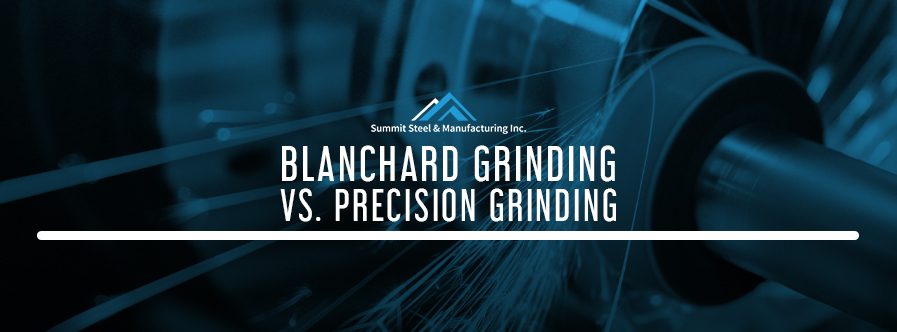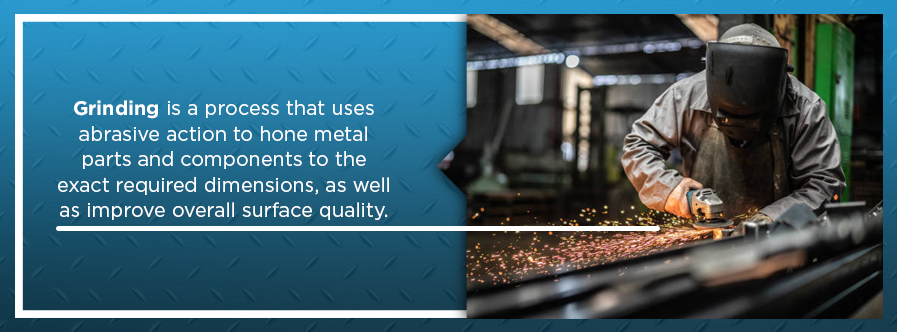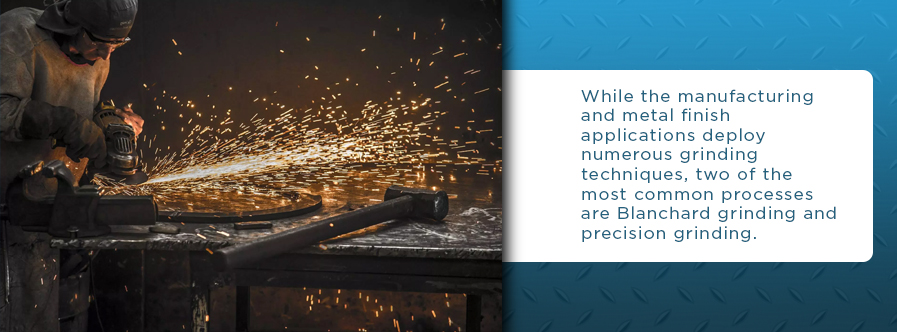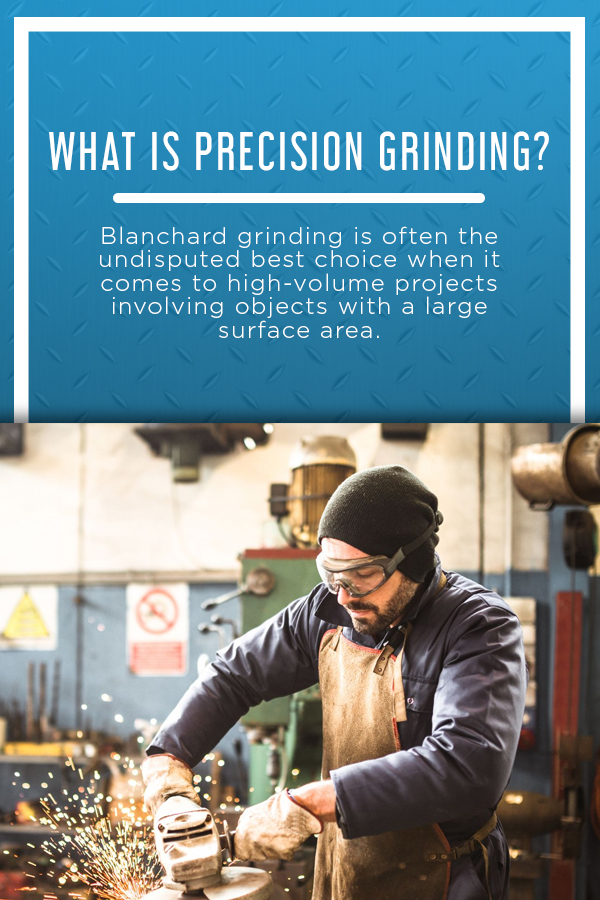
Today, we want to explain one of the processes many metal fabricators use to help create the finished products they deliver to clients. This process is known as grinding, and we’ll talk about what it involves, as well as some of the different variations you may encounter and the advantages and disadvantages each method has to offer.
Grinding is technically a subset of the cutting processes many metal workers and fabricators use. Like all cutting processes, it is designed to trim and shear away unwanted sections of metal that will not be part of the final product. By this definition, it has much in common with other types of cutting or trimming, even outside the metalworking industries.
Beyond these initial similarities, however, we can see grinding also has many differences when compared to other types of cutting. Because of these differences, grinding usually gets categorized as part of the finishing process. It often comes into play toward the end of the fabricating process, rather than at the beginning when the body of the product is coming together. But what exactly does grinding do?

Metal fabricators primarily use grinding for shaving away unwanted pieces of material to make the resulting product fit exactly with the needed dimensions. Metal fabricators typically employ grinding to perform this function instead of other types of cutting because grinding wheels can remove the tiniest metal shavings. Typically, other cutting tools can only remove metal in larger chunks.
Metal grinding has another purpose in addition to this trimming and shaving, however. It can also help finish off a metal surface, smoothing down the metal and removing ridges, abrasions and aberrations in the surface. This process is also technically a kind of shaving, but the purpose is less about removing pieces of metal and more about giving the metal surface a clean and even finish. While grinding as a method of metal removal will likely take place as an earlier step in the fabrication process, this type of finishing is much more likely to come near the end.
The great strength of metal grinding is that it offers the gift of precision. Depending on which method of grinding the metalworkers use, these machines can easily perform the most minute tasks with almost exact perfection. This accuracy allows machine shops to create precise, small parts that all fit together exactly to create the desired final product. Not every type of grinding specializes in this precision work, but the process has a reputation for bringing this strength to the world of metal fabrication.
We’ve mentioned there are several different types of grinding, and that each of these types brings something a bit different to the process. None of these grinding techniques are inherently better or worse than any of these others. Rather, they can each be extremely useful when employed at the right moment and in the right circumstances, and each has a unique list of pros and cons.

Blanchard grinding is a system developed by and named after the Blanchard Machine Company of Cambridge, Mass., in the early 20th century. This system offers a fast and exceptionally cost-effective method for removing large amounts of material over an expansive surface area. While it isn’t quite as precise as other grinding techniques, it’s still more accurate than most cutting methods, and is furthermore effective over large surfaces.
Also known as rotary surface grinding, the Blanchard technique involves the use of either magnets or specially designed holders that secure the component and hold it in place. Machine operators pair this setup with the Blanchard grinding machine, which consists of a wheel that mounts on a vertical spindle. This spindle rotates the wheel in the opposite direction of the magnets holding the object. This way, the grinding occurs only along one side of the working piece. Once the grinding is finished, a Blanchard machine leaves a distinctive pattern of cross-hatching across the ground surface, adding an extra visual element to the final appearance of the object.
Blanchard grinding is most frequently a tool of metal workers, who use this method to shape ferrous metals — those which contain iron. It isn’t the only possible application, however. Blanchard grinding also works with some non-ferrous metals and even certain plastics, although these two latter applications typically involve higher costs and slower production times. Because of these two drawbacks, most metalworkers only use Blanchard grinding for ferrous metals.
Why might a metal fabricator choose to use Blanchard grinding over the alternative grinding methods available to them? Here are just a few of the benefits of picking Blanchard grinding.
Blanchard grinding offers plenty of benefits to those who choose to use it, but it isn’t a perfect system, and there are plenty of situations it cannot handle. Here are just a few of the limitations you’ll want to be aware of with this system.
Examples of typical Blanchard grinding applications include finishing large sections of plate stock, castings, forgings, stampings, rotary tables and die blocks.

There are several different methods of precision grinding. This term doesn’t denote a single type of grinding, and rather refers to a subset of grinding methods that all prioritize extreme levels of precision above all else. Here are a few examples of grinding techniques that fall under the umbrella of precision grinding.
In a typical precision grinding process, a wheel grinds the surface down to the exact specifications of the project, all while using the utmost precision. In addition to this shaping and shaving, however, this grinding process produces a smooth surface unmarked by bumps, ridges or patterns. This surface is then ready for a paint or powder coating, or left as-is.
Like Blanchard grinding, precision grinding is primarily a tool of metal fabricators. Just a few examples of materials that are compatible with precise grinding include silicon carbide, aluminum oxide and zirconia alumina.
What makes precision grinding the best choice for a variety of different applications and situations? Here are a few of the reasons metal fabricators are choosing precision grinding for their work.
Precision grinding is an excellent tool that’s just right for a variety of applications, but it isn’t always ideal for every situation. In some cases, other types of grinding might be better for the job at hand. To demonstrate this, here are just a few of the limitations of precision grinding to be aware of.
Which is better: Blanchard or precision grinding? We hope it’s clear this isn’t a question with a consistent and clear answer. Both have remarkable strengths, but neither can handle every project a metal fabricator might encounter. Rather than asking which of the two methods is better, however, it’s far more useful to ask which is more appropriate for the task at hand.
Blanchard grinding will nearly always be the better choice for large tasks where speed is a priority, and tiny details and precision work aren’t quite as crucial. On the other hand, if you’re dealing with things on a small scale where accuracy is of the essence, you’ll want to choose precision grinding every time. This comparison serves not to show which method of grinding is better, but the way the two complement one another by specializing in different areas of grinding.